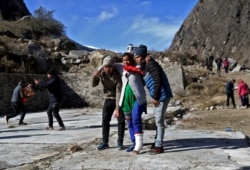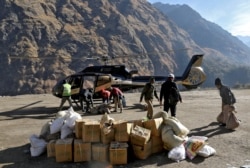Environmentalists who have long warned about the double jeopardy posed by climate change and unsustainable development projects in the Himalayan mountains say the recent flash flood in northern India should be a wake-up call for authorities pressing ahead with hydropower and road projects.
Experts investigating the disaster say it was likely caused by a massive chunk of rock that hurtled down in Uttarakhand state Sunday. At least 36 people died and about 200 are still missing.
“It seems that the rock mass got weakened due to freezing and thawing process due to the climate change phenomenon and crashed down along with a glacier hanging on it,” said Kalachand Sain, head of the Wadia Institute of Himalayan Geology. “It then created an artificial dam that breached and caused the flood.”
A team of scientists from the institute is conducting a detailed survey to ascertain the cause of the disaster.
The torrent of water, mud and debris that coursed down the mountainside washed away roads and bridges, swallowed one dam in its path and damaged another hydropower project under construction. Many of those missing are construction workers -- for days, rescue teams have focused their efforts on a tunnel where they have been trapped, although hopes of finding them alive are receding. Thirteen villages were cut off by the flood.
“This was a disaster waiting to happen,” said Ravi Chopra, director of the People’s Science Institute. He was member of a committee set up India’s Supreme Court to study the impact of hydropower projects that dot the mountains in the state.
“The construction of hydropower projects is quite destructive to the environment and aggravates the impact of floods in the Himalayan region that may be caused by climate change,” he said.
The study was commissioned after flash floods in 2013 that killed about 6,000 people in the same state. The committee had suggested that hydropower projects should not be built at an altitude of more than 2000 meters as this was a “para glacial zone” that could be prone to flooding. Both the dams affected by the recent flood lay above that altitude.
Environmentalists have long flagged retreating glaciers as a huge threat to millions of people in the Himalayan region – the melting ice creates glacial lakes and natural dams, which can breach and trigger floods down the valley. In the event of a flash flood, the earth, rocks, and debris left behind by retreating glaciers cause intense damage in populated valleys that are already vulnerable from the blasting of mountainsides and cutting of trees for roads and hydroelectric projects.
Rising temperatures could melt away one-third of the Himalayan glaciers by the end of the century, according to a report by the International Center for Integrated Mountain Development. The loss will be much higher if carbon emissions are not cut, other studies have said.
Experts are not alone in their concerns about the Himalayas. Residents of Raini, one of the villages worst affected by Sunday’s avalanche petitioned Uttarakhand’s top court in 2019 to investigate environmentally hazardous practices at a nearby power plant that was destroyed in the recent flood.
The tiny settlement of about 150 families is no stranger to environmental activism; it was part of a movement that began in the 1970s to prevent the felling of trees. Now villagers are demanding that they be relocated to a safer place, as they fear another deluge after authorities said that a lake may have formed in the vicinity of the village following the flood.
Concerns have also been voiced about a project to widen about 900 kilometers of roads that snake along the Himalayan mountains to four Hindu holy shrines. Initial plans for 10-meter-wide roads have been scaled back to 5.5 meters under a Supreme Court order.
The government has said the roads would bring economic benefits to the region and were needed for military deployment to the border with China.
Several members of a committee appointed by the court to look into the environmental impact of the highway project said it could cause “irreversible damage” to the Himalayas.
“The Himalayas are a young, fragile mountain chain, it is mud and rock held together,” said Chandra Bhushan, head of the International Forum for Environment, Sustainability and Technology in New Delhi.
“When you blast hillsides and cut trees to build wide roads and develop power projects, we make them more sensitive,” he said.
After the latest tragedy, the chief minister of Uttarakhand state, Trivendra Singh Rawat, warned against seeing the flooding as “a reason to build anti-development narrative.”
“I reiterate our government’s commitment to develop hills of Uttarakhand in a sustainable manner, and we will leave no stone unturned in ensuring the achievement of this goal,” he said on Twitter earlier this week.
Experts say they recognize the need for development projects in a region that remains poor, with little access to resources such as water, sanitation and healthcare.
“I have seen the tragedy of women walking kilometers to fetch water as streams dry up because of climate change,” Anjal Prakash, lead author of the ongoing sixth assessment report of the United Nations Intergovernmental Panel on Climate Change, said.
However, he said the focus must move to more sustainable projects such as micro hydro, solar and wind energy.
“We need to understand the local ecology and take environmental considerations into account. Otherwise, the risk of disasters is going to be much more in future, both in terms of magnitude and frequency,” he said.











